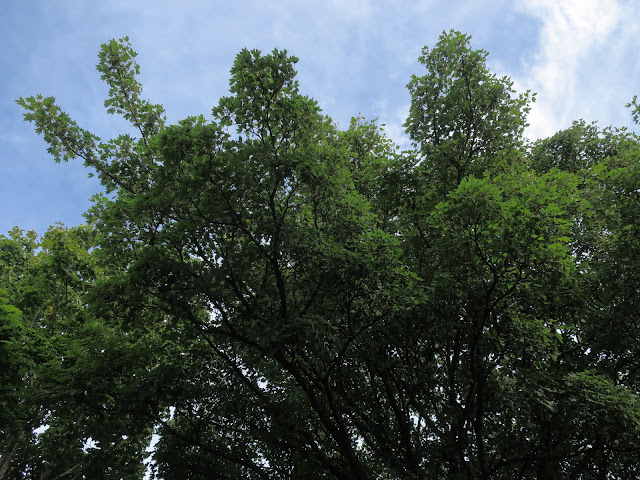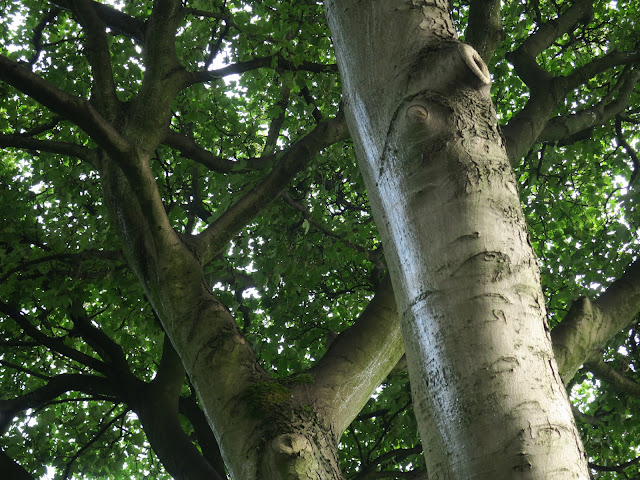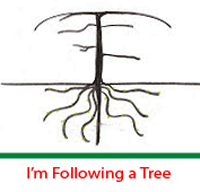 |
| Scruffy hart's tongues ferns in wall. June 1st 2020. |
Do you remember this picture?
It's of bedraggled Hart's Tongue ferns in the wall outside my house on 1st June 2020.
Something apparently unconnected; do any of you read
Karen Gimson's blog? (Recommended!) Well, at the beginning of March, Karen was giving away a
Hozelock Bokashi Composter and I 'won' it by leaving a comment and my name came out of the hat.
This kind of composter lives indoors. There are no worms but a sort of magical sawdust that you sprinkle onto food you put in the large-bucket sized, grey and yellow plastic box. Incredibly, it can be cooked as well as uncooked food, animal as well as vegetable. (Even bones.) I haven't been very adventurous with it. I find I am conservative about what I think 'ought' to go into a compost bin and these conventions are hard to overcome. However, feeling rather brave, adventurous and reckless even I have included pasta from time to time. It's now got to the point where I must get someone to dig a hole in the ground at my allotment and bury the contents. (Perhaps I will ask them to sing mystical chants while they do it!) But in between then and now, twice a week, I have opened a tap at the bottom and let a slightly yellow, slightly cabbagy smelling liquid flow out. I've diluted it with water and poured it over the hart's tongue ferns using a little red watering can with a long, thin spout - rather like an old fashioned oil can.
 |
| The same hart's tongue ferns on 1st August 2020/ |
And this is the result!
All previous hart's tongue ferns I have come across have been growing on woodland slopes or at the edge of county ditches where there would always be some kind of decaying vegetation. These must have been hungry as well as thirsty. Just look at them now! Not only have the original ones revived, more have appeared - presumably encouraged by the dribble of water and nutrients through the channels of old mortar. I've just counted forty. FORTY!
 |
| Petty spurge. 1st August 2020 |
Because of the rules of the pandemic and my lack of immunity to the bacteria in soil I have still not been able to visit my allotment but I'm trying to make the most of the little area outside my house. Fortunately, it's at the dead end of a blocked off street so the large pots I've placed along the pavement don't get in anyone's way. As well as extending growing space this has the advantage of expanding the distance between me (on my doorstep) and anyone who might be passing by. (Virus anti-sociability!) There's also a little concreted area where trays can go and a tiny patch of earth 70 inches by 22 inches. (I've just measured it.) During June, one of our two cats died. We buried her there and sprinkled four kinds of flower seeds which sprang up and were promptly eaten by slugs. I had some spare red kale plants whose leaves are pretty as well as edible so I planted them instead. Slugs ate
them! I had grown rudbeckia from seed. I put them there. Slugs ate them! Never mind. Instead of bright colours, I have a little army of petty spurges. They just arrived. I didn't plant the hart's tongue ferns, I didn't plant the petty spurge. The big deal is that slugs and pests are avoiding both and both are now happily growing. I have a garden!
 |
| Small foxglove plant. 1st August 2020 |
Foxglove seeds had fallen from the garden in Dorset into a couple of pots which came with me when I moved to Halifax. Slugs and snails ignore them. They have flowered and dropped extra seed. Now transplanted into the earth, hopefully these new plants will flower next year. There are lots of foxgloves growing wild locally. When they start to drop seeds I'll collect some so I will have even more. Whatever grows (almost whatever grows!) is welcome!
 |
Aquilegia. 5th June 2020
|
Remember this picture? It is of some rather exotic looking aquilegia growing nearby. I've collected seeds from them and sprinkled them on the earth. Hopefully, they will grow and I will have exotic flowers outside my house too next June. (I've kept some in an envelope and can start them in pots in spring if I need a fall back.)
 |
| Small, self-sown cyclamen now put in pots. 1st August 2020. |
The trouble with cats is that they like sitting on things and my remaining cat is an enthusiastic window-box-plant-squasher. Last year I planted cyclamen in the window boxes. Squashed! Dead! Breaking my arm didn't help. I couldn't water things as much as they needed. But eight baby cyclamen have sprung up in their place. Two I've left in the boxes. The other six I am now nurturing in separate pots. Of their own accord they are perpetuating the line. They are welcome!
 |
| Lobelia flowering in stripey Yucca pot. 1st August 2020 |
This pot came with me from Dorset. It contains a stripy Yucca plant and a foxglove seedling. Also some lobelia. The lobelia came from Dorset - at least, its ancestors did. I bought a few plants several years ago and they have been self-seeding ever since.
 |
| Geranium in pot. Grown on from plug. 1st August 2020. |
And last, but not least, geraniums. I have not been into a shop for months but Diana at
Elephant's Eye on False Bay pointed out that the large windows in my house might have been intended with a weaver in mind and that weavers traditionally had geraniums in their window boxes. How could I resist? I looked online but geraniums seemed very expensive so I asked my neighbour to keep an eye out for me in the local shops and she came across a wonderful bargain - eighteen plug plants for £1:77! Enough for her to have some on her windowsills too. I've potted them up and when they get round to flowering we will have a right gaudy and joyous display at our end of the street.
 |
More hart's tongue ferns in the same brick wall. 1st August 2020.
|
Sorry, I'm so chuffed with the hart's tongue ferns I need to show you another group in the same wall.
Nature, in the form of lack of water, of slugs and snails can be destructive. But there can be hardly anywhere in this country where absolutely nothing will grow. I will not necessarily be able to have the plants I first thought of but nature (and my neighbour!) are filling the gaps. What grows is welcome. Plants which choose to be here of their own accord or are from the immediate environs are those most likely to survive - and that, so far, with a little bit of nudging, is what they are doing!













